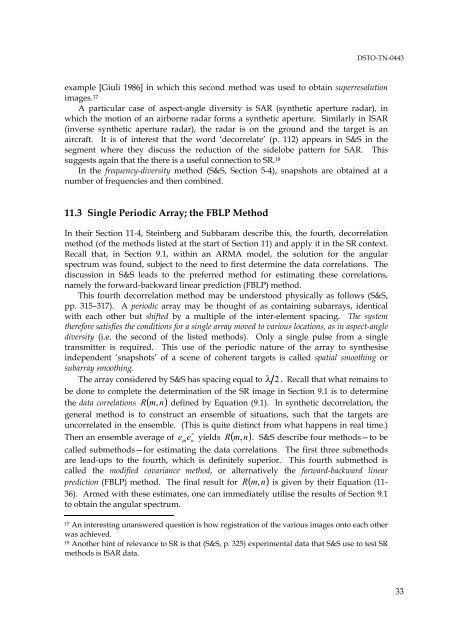Suitability of Correlation Arrays and Superresolution for Minehunting ...
Suitability of Correlation Arrays and Superresolution for Minehunting ...
Suitability of Correlation Arrays and Superresolution for Minehunting ...
Create successful ePaper yourself
Turn your PDF publications into a flip-book with our unique Google optimized e-Paper software.
DSTO-TN-0443<br />
example [Giuli 1986] in which this second method was used to obtain superresolution<br />
images. 17<br />
A particular case <strong>of</strong> aspect-angle diversity is SAR (synthetic aperture radar), in<br />
which the motion <strong>of</strong> an airborne radar <strong>for</strong>ms a synthetic aperture. Similarly in ISAR<br />
(inverse synthetic aperture radar), the radar is on the ground <strong>and</strong> the target is an<br />
aircraft. It is <strong>of</strong> interest that the word ‘decorrelate’ (p. 112) appears in S&S in the<br />
segment where they discuss the reduction <strong>of</strong> the sidelobe pattern <strong>for</strong> SAR. This<br />
suggests again that the there is a useful connection to SR. 18<br />
In the frequency-diversity method (S&S, Section 5-4), snapshots are obtained at a<br />
number <strong>of</strong> frequencies <strong>and</strong> then combined.<br />
11.3 Single Periodic Array; the FBLP Method<br />
In their Section 11-4, Steinberg <strong>and</strong> Subbaram describe this, the fourth, decorrelation<br />
method (<strong>of</strong> the methods listed at the start <strong>of</strong> Section 11) <strong>and</strong> apply it in the SR context.<br />
Recall that, in Section 9.1, within an ARMA model, the solution <strong>for</strong> the angular<br />
spectrum was found, subject to the need to first determine the data correlations. The<br />
discussion in S&S leads to the preferred method <strong>for</strong> estimating these correlations,<br />
namely the <strong>for</strong>ward-backward linear prediction (FBLP) method.<br />
This fourth decorrelation method may be understood physically as follows (S&S,<br />
pp. 315–317). A periodic array may be thought <strong>of</strong> as containing subarrays, identical<br />
with each other but shifted by a multiple <strong>of</strong> the inter-element spacing. The system<br />
there<strong>for</strong>e satisfies the conditions <strong>for</strong> a single array moved to various locations, as in aspect-angle<br />
diversity (i.e. the second <strong>of</strong> the listed methods). Only a single pulse from a single<br />
transmitter is required. This use <strong>of</strong> the periodic nature <strong>of</strong> the array to synthesise<br />
independent ‘snapshots’ <strong>of</strong> a scene <strong>of</strong> coherent targets is called spatial smoothing or<br />
subarray smoothing.<br />
The array considered by S&S has spacing equal to λ 2 . Recall that what remains to<br />
be done to complete the determination <strong>of</strong> the SR image in Section 9.1 is to determine<br />
the data correlations R ( m, n)<br />
defined by Equation (9.1). In synthetic decorrelation, the<br />
general method is to construct an ensemble <strong>of</strong> situations, such that the targets are<br />
uncorrelated in the ensemble. (This is quite distinct from what happens in real time.)<br />
∗<br />
Then an ensemble average <strong>of</strong> e me n<br />
yields R ( m, n)<br />
. S&S describe four methods—to be<br />
called submethods—<strong>for</strong> estimating the data correlations. The first three submethods<br />
are lead-ups to the fourth, which is definitely superior. This fourth submethod is<br />
called the modified covariance method, or alternatively the <strong>for</strong>ward-backward linear<br />
prediction (FBLP) method. The final result <strong>for</strong> R ( m, n)<br />
is given by their Equation (11-<br />
36). Armed with these estimates, one can immediately utilise the results <strong>of</strong> Section 9.1<br />
to obtain the angular spectrum.<br />
17 An interesting unanswered question is how registration <strong>of</strong> the various images onto each other<br />
was achieved.<br />
18 Another hint <strong>of</strong> relevance to SR is that (S&S, p. 325) experimental data that S&S use to test SR<br />
methods is ISAR data.<br />
33

















